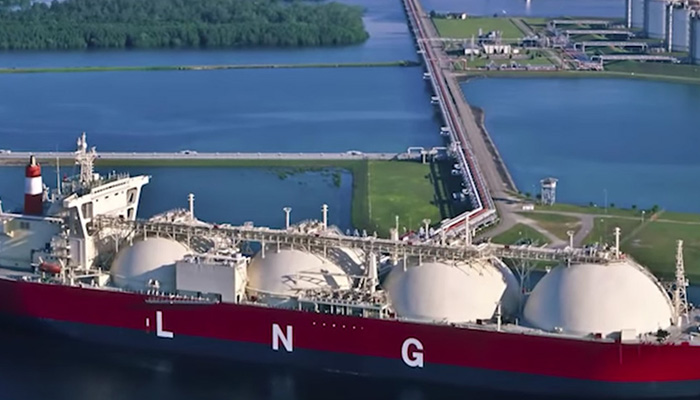Mitsubishi’s subsidiary plans merchant LNG terminal
A local subsidiary of Mitsubishi Corp Japan planned to set up a 750 million metric cubic feet/day (mmcfd) of LNG import and re-gasification terminal at Port Qasim.
KARACHI: A local subsidiary of Mitsubishi Corp Japan planned to set up a 750 million metric cubic feet/day (mmcfd) of LNG import and re-gasification terminal at Port Qasim.
The subsidiary Tabeer Energy will install a floating storage re-gasification unit (FSRU), officials said on Tuesday. “We are very actively working throughout the value chain to ensure LNG (liquefied natural gas) from the international market can flow into Pakistan’s private sector,” an industry official said, requesting anonymity.
“Ogra’s (Oil and Gas Regulatory Authority) provisional licence is in place, and we are working towards all the necessary procedures both from commercial and technical perspectives.”
Pakistan with a population of over 200 million and economic growth of 5.6 percent has the growing appetite for LNG imports, which are expected to climb fivefold to 30 million tons a year by 2022.
Analysts said the country is facing an increasing shortfall of natural gas supply aggravated by declining local gas production. The current shortfall is approximately two billion cubic feet/day (bcfd) and is projected to reach up to four bcfd by 2020 unless additional gas import projects are secured.
“Our base case is to go for a merchant model subject to commercial discussions with stakeholders in the industry,” the official said, referring to the existing two terminals that provide re-gasification services, but the government imports LNG.
A joint venture of Shell, Engro, Gunvor and Fatima Group also planned to launch the merchant LNG terminal of 750mmcfd within the next two years.
Pakistan has become the sixth largest LNG market in recent years with two LNG facilities of 1.2bcfd established in the previous government of Pakistan Muslim League (Nawaz). The country imported more than 10 million tons of LNG in the last three years, which is a cheaper source of energy than furnace and diesel oil. Around 80 percent of the imports have been under long- and medium-term supply agreements, while the remaining is based on spot market procurement.
LNG receiving terminals that use FSRUs can be installed at lower cost and constructed within a shorter period than conventional onshore receiving terminals, and are an effective means to build LNG capacity in emerging countries.
The industry official, on the upcoming merchant facility, said its cost is dependent on the outcome of technical studies and commercial structuring. “However, the potential project will require substantial amount of investment into Pakistan to contribute to its economy and growth by bringing stable and reliable supply of molecules,” the official said.
Developing a privately-funded integrated LNG import project linking LNG supply to downstream gas markets will help bridge the LNG supply gap, provide additional security of supply to power, industrial, and compressed natural gas sectors, and transfer the financial burden and risk from the public to the private sector and contribute tax revenues.
-
 Piers Morgan Finally Reacts To Brooklyn Beckham's Statement About David And Victoria Beckham
Piers Morgan Finally Reacts To Brooklyn Beckham's Statement About David And Victoria Beckham -
 Tom Hiddleston Reveals Unlikely DC Character That Inspired Loki
Tom Hiddleston Reveals Unlikely DC Character That Inspired Loki -
 Prince Harry, Meghan Markle Warned 2026 Will Be 'a Big Test' For Them
Prince Harry, Meghan Markle Warned 2026 Will Be 'a Big Test' For Them -
 OpenAI Plans First ChatGPT Device For 2026
OpenAI Plans First ChatGPT Device For 2026 -
 Matt Damon Gets Slammed Over 'out Of Touch' Comparison
Matt Damon Gets Slammed Over 'out Of Touch' Comparison -
 From Chagos Islands To Greenland Trump Flags National Security Risks: Here’s Why
From Chagos Islands To Greenland Trump Flags National Security Risks: Here’s Why -
 Meghan’s UK Return As ‘successful Businesswoman’ Will Put Pressure On Kate Middleton
Meghan’s UK Return As ‘successful Businesswoman’ Will Put Pressure On Kate Middleton -
 Spotify Tests Page Match To Sync Books With Audiobooks
Spotify Tests Page Match To Sync Books With Audiobooks -
 King Charles Breaks Cover Amid Prince Harry's Presence In Britain
King Charles Breaks Cover Amid Prince Harry's Presence In Britain -
 Real Reason King, William, Kate Have Arranged To Avoid Harry During UK Trip
Real Reason King, William, Kate Have Arranged To Avoid Harry During UK Trip -
 Trump Trolls European Leaders With AI Map Showing Greenland As U.S. Territory
Trump Trolls European Leaders With AI Map Showing Greenland As U.S. Territory -
 AI Vs Reality: How Deepfakes Are Warping Story Of Maduro’s US Capture
AI Vs Reality: How Deepfakes Are Warping Story Of Maduro’s US Capture -
 Why Ryan Coogler Got Worried After Pitching 'Sinners' To Michael B Jordan
Why Ryan Coogler Got Worried After Pitching 'Sinners' To Michael B Jordan -
 Princess Diana's Brother Shares Emotional Post After Prince Harry Returns To UK Without Meghan, Archie, Lilibet
Princess Diana's Brother Shares Emotional Post After Prince Harry Returns To UK Without Meghan, Archie, Lilibet -
 'Disgraced' Andrew Gets Away With Major Double Standard Over Royal Lodge
'Disgraced' Andrew Gets Away With Major Double Standard Over Royal Lodge -
 Carson Beck Girlfriend Rumours Explained Amid CFP Championship Run
Carson Beck Girlfriend Rumours Explained Amid CFP Championship Run




